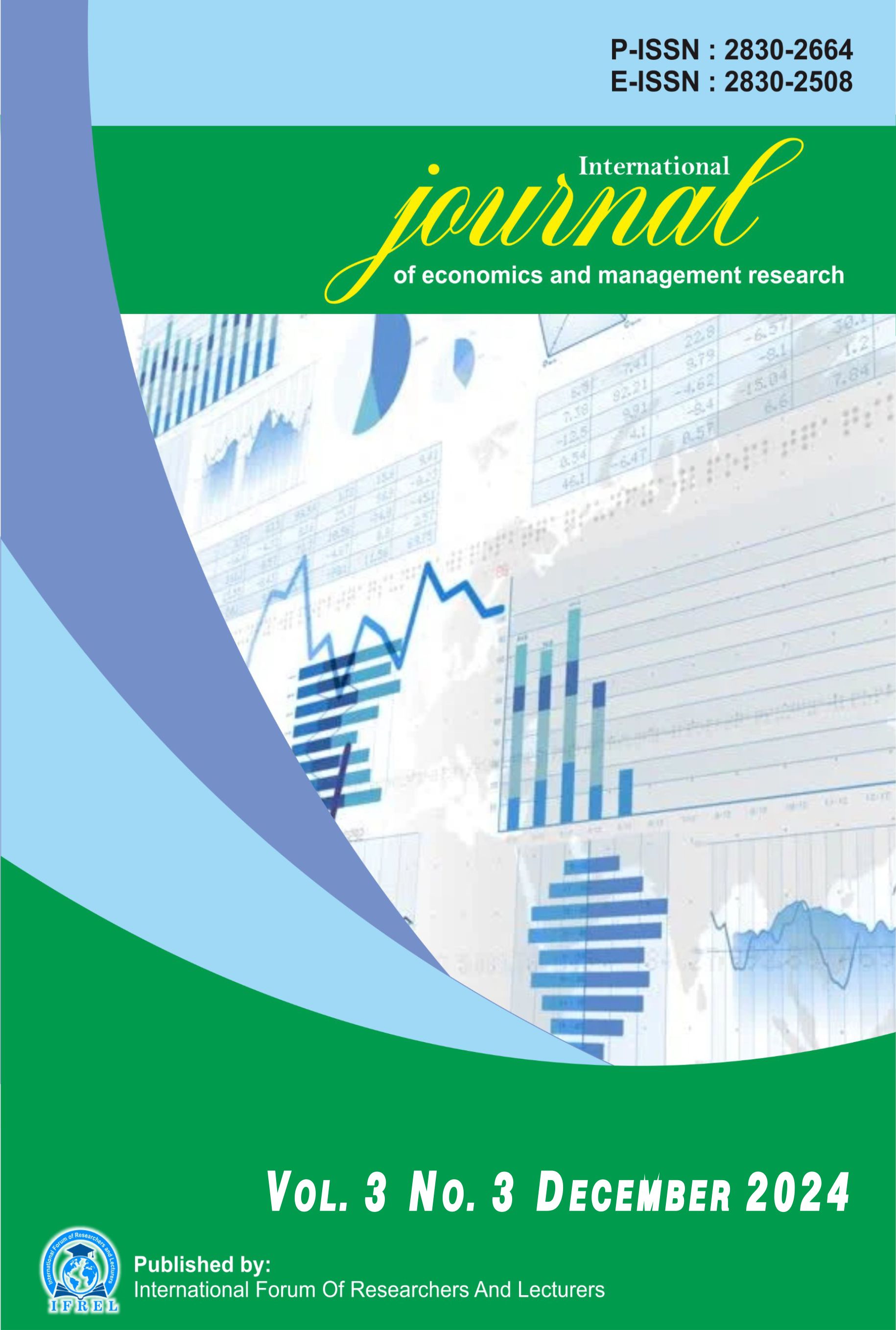Linking Green Empowerment and Environmental Performance through Green innovative work behavior: Evidence from Indonesia
DOI:
https://doi.org/10.55606/ijemr.v3i3.595Keywords:
Green Empowerment; Green Innovative Work Behavior; Environmental Performance; Hospitality IndustryAbstract
In the context of sustainable hospitality, the empowerment of employees in embracing environmentally responsible practices is increasingly recognized as a driver of organizational performance. This study investigates the influence of Green Empowerment on Environmental Performance, with Green Innovative Work Behavior serving as a mediating factor. The research addresses the question of how empowering frontline employees can foster pro-environmental behaviors that contribute to measurable improvements in hotel sustainability outcomes. A quantitative research design was employed using a survey method, targeting a sample of 150 frontline hotel employees in Indonesia selected through purposive sampling. Data were analyzed using WarpPLS to test the proposed structural model and relationships among variables. The analysis reveals that Green Empowerment has a significant positive effect on Green Innovative Work Behavior, which in turn significantly enhances Environmental Performance. Moreover, the mediating role of Green Innovative Work Behavior highlights the importance of fostering creativity and innovation in environmental practices to translate empowerment into tangible sustainability outcomes. The synthesis of findings suggests that hotels can strengthen their environmental performance by cultivating empowerment initiatives that encourage employees to develop and implement innovative green practices. This study concludes that frontline employee engagement through empowerment and innovative behavior is a strategic pathway for the hospitality industry to achieve sustainable performance.
References
[1] Z. Elkhwesky, “A systematic and major review of proactive environmental strategies in hospitality and tourism: Looking back for moving forward,” Bus. Strateg. Environ., vol. 31, no. 7, pp. 3274–3301, 2022, doi: 10.1002/bse.3076.
[2] Y. Yang, L. Jiang, and Y. Wang, “Why do hotels go green? Understanding TripAdvisor GreenLeaders participation,” Int. J. Contemp. Hosp. Manag., vol. 35, no. 5, pp. 1670–1690, Oct. 2022, doi: 10.1108/IJCHM-02-2022-0252.
[3] K. Badar, Y. M. Kundi, A. N. Siddiquei, and A. Abualigah, “Linking environmentally-specific empowering leadership to hotel employees’ green creativity: understanding mechanisms and boundary conditions,” J. Serv. Theory Pract., vol. 33, no. 3, pp. 412–435, Mar. 2023, doi: 10.1108/JSTP-07-2022-0158.
[4] M. Aboramadan, J. Crawford, M. A. Türkmenoğlu, and C. Farao, “Green inclusive leadership and employee green behaviors in the hotel industry: Does perceived green organizational support matter?,” Int. J. Hosp. Manag., vol. 107, no. December 2021, p. 103330, 2022, doi: 10.1016/j.ijhm.2022.103330.
[5] M. Aboramadan, “The effect of green HRM on employee green behaviors in higher education: the mediating mechanism of green work engagement,” Int. J. Organ. Anal., vol. 30, no. 1, pp. 7–23, Jan. 2022, doi: 10.1108/IJOA-05-2020-2190.
[6] S. H. Bhatti, F. Saleem, G. Murtaza, and T. U. Haq, “Exploring the impact of green human resource management on environmental performance: the roles of perceived organizational support and innovative environmental behavior,” Int. J. Manpow., vol. 43, no. 3, pp. 742–762, Sep. 2021, doi: 10.1108/IJM-05-2020-0215.
[7] A. Abualigah, K. Badar, Q. A. Nisar, and O. M. Karatepe, “A moderated mediation model of green human resource management,” Serv. Ind. J., vol. 44, no. 7–8, pp. 457–479, 2024, doi: 10.1080/02642069.2024.2332995.
[8] I. Huertas-Valdivia, A. R. Gallego-Burín, and F. J. Lloréns-Montes, “Effects of different leadership styles on hospitality workers,” Tour. Manag., vol. 71, no. October 2018, pp. 402–420, 2019, doi: 10.1016/j.tourman.2018.10.027.
[9] K. H. Fong and E. Snape, “Empowering leadership, psychological empowerment and employee outcomes: Testing a multi-level mediating model,” Br. J. Manag., vol. 26, no. 1, pp. 126–138, 2015, doi: 10.1111/1467-8551.12048.
[10] M. Aboramadan, Y. M. Kundi, and C. Farao, “Examining the effects of environmentally-specific servant leadership on green work outcomes among hotel employees: the mediating role of climate for green creativity,” J. Hosp. Mark. Manag., vol. 30, no. 8, pp. 929–956, 2021, doi: 10.1080/19368623.2021.1912681.
[11] L. T. Tuan, “Disentangling green service innovative behavior among hospitality employees: The role of customer green involvement,” Int. J. Hosp. Manag., vol. 99, no. January, p. 103045, 2021, doi: 10.1016/j.ijhm.2021.103045.
[12] S. Roscoe, N. Subramanian, C. J. C. Jabbour, and T. Chong, “Green human resource management and the enablers of green organisational culture: Enhancing a firm’s environmental performance for sustainable development,” Bus. Strateg. Environ., vol. 28, no. 5, pp. 737–749, 2019, doi: 10.1002/bse.2277.
[13] L. Yang et al., “Advancing the debate on hotel employees’ environmental psychology by promoting energy-saving behavior in a corporate social responsibility framework,” Front. Psychol., vol. 13, no. September, pp. 1–15, 2022, doi: 10.3389/fpsyg.2022.990922.
[14] A. Siddiquei, F. Asmi, M. A. Asadullah, and F. Mir, “Environmental-specific servant leadership as a strategic tool to accomplish environmental performance: a case of China,” Int. J. Manpow., vol. 42, no. 7, pp. 1161–1182, Jan. 2021, doi: 10.1108/IJM-07-2020-0350.
[15] S. E. Hobfoll, “The influence of culture, community, and the nested-self in the stress process: Advancing conservation of resources theory,” Appl. Psychol., vol. 50, no. 3, pp. 337–421, 2001, doi: 10.1111/1464-0597.00062.
[16] L. Li, Z. Yi, F. Jiang, S. Zhang, and J. Zhou, “Exploring the mechanism of digital transformation empowering green innovation in construction enterprises,” Dev. Built Environ., vol. 15, no. July, p. 100199, 2023, doi: 10.1016/j.dibe.2023.100199.
[17] S. Safarzadeh, A. Hafezalkotob, and H. Jafari, “Energy supply chain empowerment through tradable green and white certificates: A pathway to sustainable energy generation,” Appl. Energy, vol. 323, no. January, p. 119601, 2022, doi: 10.1016/j.apenergy.2022.119601.
[18] S. Al-Ayed, “Green innovation influenced by employee innovative work behavior via moderating role of innovative leaderships,” Cogent Bus. Manag., vol. 11, no. 1, p., 2024, doi: 10.1080/23311975.2024.2393741.
[19] W. H. Zainurrafiqi , Ria Racawati , Devi Lestari Pramita Putri , Enza Resdiana , Endang Widyastuti , Qaiyim Asy’ari , Rusdiyanto, “The Determinants And Consequents Of Competitive Advantage Based Of Local Wisdom At The Micro, Small, And Medium Enterprise : Evidence From Indonesia,” Solid State Technol., vol. 63, no. 6, pp. 1604–1620, 2020, [Online]. Available: http://solidstatetechnology.us/index.php/JSST/article/view/2260
[20] Z. and Gazali, “Supply Chain Digitalization, Green Supply Chain, Supply Chain Re-silience Toward Competitiveness and MSMEsPerformance,” J. Apl. Manaj., vol. 22, no. 1, pp. 175–192, 2023, doi: http://dx.doi.org/10.21776/ub.jam.2024.022.01.14.
[21] Z. and Gazali, “Pengaruh Digitalisasi Rantai Pasokan Dan Rantai Pasokan Hijau Terhadap Daya Saing Usaha Mikro Kecil Menengah Di Kabupaten Pamekasan,” Public Corner Fak. Ilmu Sos. Dan Ilmu Polit., vol. 18, no. 2, pp. 69–81, 2023, doi: https://doi.org/10.24929/fisip.v18i2.2973.
[22] Zainurrafiqi & Siti Salama Amar, “Pengaruh Innovation Capability dan Blue Ocean Strategy terhadap Competitive Advantage dan Business Performance,” Assyarikah J. Islam. Econ. Bus., vol. 2, no. 2, pp. 73–100, 2021, doi: https://doi.org/10.28944/assyarikah.v2i2.438.
[23] Zainurrafiqi dan Nurul Hidayati, “Pengaruh Financial literacy terhadap Financial Behavior dan Firm Performance dengan Religiosity Sebagai Variabel Moderasi (Survey pada Usaha Mikro Kecil Menengah Di Madura),” Public Corner, vol. 16, no. 2, pp. 100–118, 2021, doi: https://doi.org/10.24929/fisip.v16i2.2205.
[24] N. F. A. Zainurrafiqi, Gazali, Zef Risal, Rachman Hakim, Rusdiyanto, “Organizational Resilience, Strategic Foresight, and Green Supply Chain Integration: A Pathway to Sustainable Performance in MSMEs Through Green Competitive Advantage,” J. Manag. World, vol. 4, no. 856–866, 2024, doi: https://doi.org/10.53935/jomw.v2024i4.552.
[25] Zainurrafiqi, Gazali, Q. Nuzulul, and H. Nurul, “The Effect of Organization Learning Capability and Organizational Innovation on Competitive Advantage and Business Performance,” Russ. J. Agric. Socio-Economic Sci., vol. 3, no. 99, pp. 9–17, 2020, doi: https://doi.org/10.18551/rjoas.2020-03.02.
[26] Z. Z. and G. Gazali, “The Effect Of Green Entrepreneur Orientation On Network Resource Acquisition And Small And Medium Enterprises’ Business Performance With Knowledge Transfer And Integration And Green Technology Dynamism as Moderator Variables,” Indones. Interdiscip. J. Sharia Econ., vol. 6, no. 1, pp. 136–153, 2023, doi: https://doi.org/10.31538/iijse.v6i1.2722n.
[27] J. F. Hair, J. J. Risher, M. Sarstedt, and C. M. Ringle, “When to use and how to report the results of PLS-SEM,” Eur. Bus. Rev., vol. 31, no. 1, pp. 2–24, 2019, doi: 10.1108/EBR-11-2018-0203.
[28] G. Sachdeva, S. Taneja, and R. Gupta, “The mediating role of green human resource management: analyze the impact of green commitment and intellectual capital in hotel environmental performance,” Energy Effic., vol. 17, no. 5, p. 49, 2024, doi: 10.1007/s12053-024-10229-6.
[29] Sakshi, Shashi, R. Cerchione, and H. Bansal, “Measuring the impact of sustainability policy and practices in tourism and hospitality industry,” Bus. Strateg. Environ., vol. 29, no. 3, pp. 1109–1126, 2020, doi: 10.1002/bse.2420.
[30] A. Ioannidis, K. J. Chalvatzis, L. C. Leonidou, and Z. Feng, “Applying the reduce, reuse, and recycle principle in the hospitality sector: Its antecedents and performance implications,” Bus. Strateg. Environ., vol. 30, no. 7, pp. 3394–3410, 2021, doi: 10.1002/bse.2809.
[31] A. Abualigah, T. Koburtay, I. Bourini, K. Badar, and A. M. Gerged, “Towards sustainable development in the hospitality sector: Does green human resource management stimulate green creativity? A moderated mediation model,” Bus. Strateg. Environ., vol. 32, no. 6, pp. 3217–3232, 2023, doi: 10.1002/bse.3296.
[32] O. M. Karatepe, H. Hsieh, and M. Aboramadan, “The effects of green human resource management and perceived organizational support for the environment on green and non-green hotel employee outcomes,” Int. J. Hosp. Manag., vol. 103, no. March, p. 103202, 2022, doi: 10.1016/j.ijhm.2022.103202.
[33] Hair, “Partial Least Squares Structural Equation Modeling (PLS-SEM): An Emerging Tool in Business Research,” . Eur. Bus. Rev. 26(2) 106-121., 2014.
[34] M. Sarstedt, J. F. Hair, C. M. Ringle, K. O. Thiele, and S. P. Gudergan, “Estimation issues with PLS and CBSEM: Where the bias lies!,” J. Bus. Res., vol. 69, no. 10, pp. 3998–4010, 2016, doi: 10.1016/j.jbusres.2016.06.007.
[35] J. F. Hair, G. T. M. Hult, and C. M. Ringle, A primer on partial least squares structural equation modeling (PLS-SEM), Second Edi. USA: SAGE Publications, 2017. [Online]. Available: http://eli.johogo.com/Class/CCU/SEM/_A Primer on Partial Least Squares Structural Equation Modeling_Hair.pdf
[36] Y. J. Kim, W. G. Kim, H. M. Choi, and K. Phetvaroon, “The effect of green human resource management on hotel employees’ eco-friendly behavior and environmental performance,” Int. J. Hosp. Manag., vol. 76, no. March 2018, pp. 83–93, 2019, doi: 10.1016/j.ijhm.2018.04.007.
[37] D. Bendig, C. Schulz, L. Theis, and S. Raff, “Digital orientation and environmental performance in times of technological change,” Technol. Forecast. Soc. Change, vol. 188, no. December 2021, p. 122272, 2023, doi: 10.1016/j.techfore.2022.122272.
[38] E. Rescalvo-Martin, A. Castillo, A. P. Moreno-Marcial, C. A. Albacete-Saez, and F. J. Llorens-Montes, “Effects of empowering leadership under boundary conditions in the hospitality industry,” Int. J. Hosp. Manag., vol. 105, no. May, p. 103269, 2022, doi: 10.1016/j.ijhm.2022.103269.
[39] D. Van Dierendonck and M. Dijkstra, “The role of the follower in the relationship between empowering leadership and empowerment: A longitudinal investigation,” J. Appl. Soc. Psychol., vol. 42, no. SUPPL. 1, pp. 1–20, 2012, doi: 10.1111/j.1559-1816.2012.01022.x.
[40] Barney, “Firm resources and sustained Competitive Advantage,” J. Manage., vol. 17, no. 1, pp. 99–120, 1991.
[41] J. van der Stoep, E. Sleebos, D. van Knippenberg, and G. van de Bunt, “The empowering potential of intergroup leadership: How intergroup leadership predicts psychological empowerment through intergroup relational identification and resources,” J. Appl. Soc. Psychol., vol. 50, no. 12, pp. 709–719, 2020, doi: 10.1111/jasp.12707.
[42] A. L. Appelbaum, E., Bailey, T., Berg, P., & Kalleberg, Manufacturing advantage: Why high-performance work systems pay off. Ithaca, New York, USA.: Cornell University Press., 2000.
[43] Teece, “J,” ., Pisano, G., Shuen, A. 1997. Dyn. Capab. Strateg. Manag. Strateg. Manag. ournal, 18(7) 509–533..
Downloads
Published
How to Cite
Issue
Section
License
Copyright (c) 2024 International Journal of Economics and Management Research

This work is licensed under a Creative Commons Attribution-ShareAlike 4.0 International License.







